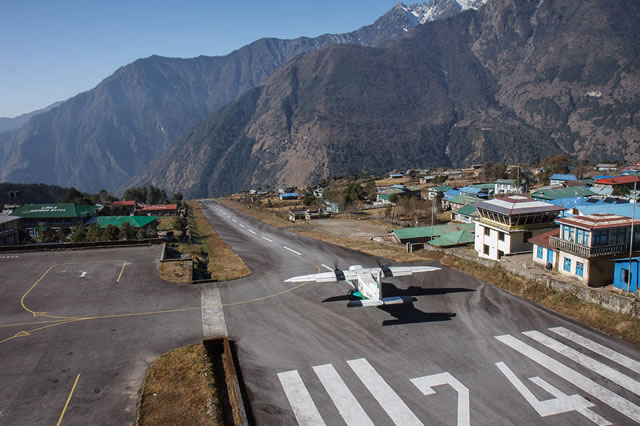The world’s most thrilling airport.The most terrifying airport inventory.
Research Statement: The Global Ranking team evaluates the world’s top ten most dangerous airports based on critical factors affecting the safety of aircraft takeoffs and landings. These factors include geographical location, altitude, visibility, wind strength, air currents, and other objective conditions, as well as the availability of runway length and other hardware facilities. The assessment also takes into account data from relevant internet rankings and lists. The provided list is for reference purposes only.
1. Lukla Airport – Nepal’s Gateway to the Himalayas
Lukla Airport, officially known as Tenzing Hillary Airport, is nestled in the remote and awe-inspiring Himalayas of northeastern Nepal, at a breathtaking altitude of 3,000 meters above sea level. As the world’s foremost dangerous airport and often referred to as “the runway on the roof of the world,” it serves as a crucial link between Kathmandu and Lukla, acting as the primary access point to Mount Everest. The airport’s short runway, spanning just 460 meters, combined with challenging weather conditions and low visibility, make for a perilous approach and landing.
Address: Lukla Town, Eastern Nepal
2. Honduras Teguntin Airport – An Airport at the Edge
Tegantín Airport, established on January 5, 1934, is situated amidst the towering Sierra Madre in Tegucigalpa, Honduras. Its runway, characterized by its limited length, demands aircraft to execute swift descents to avert potentially catastrophic encounters with the surrounding terrain. Unfortunately, the airport has a history of incidents, with an average of 3 to 4 runway overrun accidents every month since 1984.
Address: Tegucigalpa, Honduras
3. St. Barth Gustaf III Airport – An Enthralling Caribbean Experience
Gustaf III Airport, located near St. Maarten in the French Caribbean, offers one of the most thrilling aviation experiences worldwide. This unique airport boasts a remarkably short 640-meter runway, enveloped by mountains on three sides. Pilots are faced with the daunting task of executing a low approach over a road and flying directly above passing cars, adding to the already complex landing procedure. Only pilots with specialized training and licenses are permitted to land at this exceptional airport.
Address: St. Martin Island, French Caribbean
4. Princess Juliana International Airport – Where Planes Skim the Beach
Princess Juliana International Airport, situated in St. Maarten’s Dutch part, is renowned for its exceptional challenges. With a steep takeoff to clear the mountainous terrain and a low-altitude approach over the adjacent beach, planes flying over the sand cause an exhilarating spectacle for beachgoers. The proximity of the landing strip to hotels, pedestrians, and vehicles makes it an intense test for pilots navigating through such close quarters.
Address: Dutch part of St. Maarten, Caribbean Sea, Netherlands
5. Gibraltar Airport – A Runway with a Roadway
Gibraltar Airport, a facility that serves both civilian and military operations, presents a distinctive setup in Europe. Its runway extends into the sea, while a four-lane road traverses the middle, creating an extraordinary scene each time an aircraft approaches or departs. Weather conditions, particularly the turbulent winds resulting from the nearby rock formations, add to the airport’s complexities.
Address: Southernmost tip of the Iberian Peninsula
6. Courchevel Airport – A Ski Resort with a Short, Steep Runway
Courchevel Airport, nestled in the French Alps, is famed for its short and undulating runway, resembling a ski jump at one end. Despite its high elevation of approximately 2,000 meters, the runway spans just over 500 meters, with a steep inclination of 18.5 degrees. Built in 1961 to accommodate vacationers, it remains a challenging destination for pilots seeking an adventurous landing experience.
Address: French Alps
7. Eagle Vail County Airfield – Conquering the Rocky Mountain Challenges
Eagle Vail County Airfield, situated in the Rocky Mountains of Coronado, west of Denver, poses some of the most difficult conditions for pilots in the northern hemisphere. Flying over mountainous terrain affects aircraft performance, and pilots must adjust their approach to counter the impact of altitude on engine power. The airport’s location in a valley restricts horizontal movement, further increasing the complexity of landings. Unpredictable weather conditions, including sudden blizzards and high winds, further contribute to the airport’s challenging reputation.
Address: USA
8. Madeira International Airport – Navigating the Winds of Funchal
Cristiano Ronaldo International Airport, also known as Madeira International Airport, is dubbed the “Kai Tak of Europe” due to its challenging location. Situated in Funchal, Madeira Island, Portugal, the airport’s proximity to mountains and coastline leads to unpredictable and strong winds, adding difficulty to landings. The original 1,500-meter runway was expanded to address the airport’s complexities.
Address: Funchal, Madeira, Portugal
9. San Diego Lindbergh Airport – Air Traffic Congestion in the City Center
Located in the vibrant city of San Diego, California, Lindbergh Airport experiences heavy air traffic, with around 550 daily takeoffs and landings. The airport’s relatively short runway compared to its size, combined with its proximity to a parking lot, demands precise and efficient maneuvering from pilots. Furthermore, the unique terrain requires aircraft to descend at a slightly higher altitude before touchdown, making it a challenging experience for aviators.
Address: USA
10. Ingalls Airport – A High-Altitude Challenge with Unpredictable Winds
Ingalls Airport, perched on a high-altitude mountain, poses significant challenges for pilots due to the strong and erratic winds prevalent in the area. The mountainous location generates chaotic airflow, making landing and takeoff particularly demanding. This airport stands out as one of the most formidable in the world, requiring experienced and skilled pilots to navigate its extreme conditions.
Address: Eastern United States

